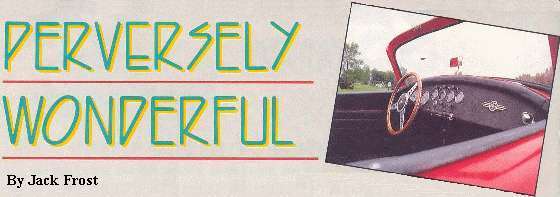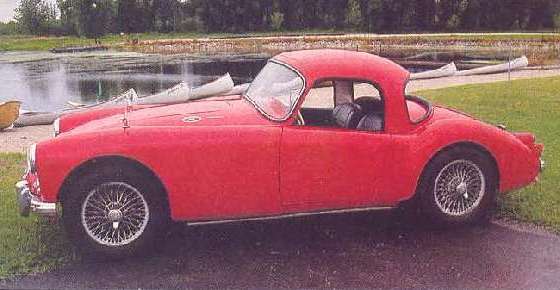The MGA With An Attitude
Special Bodies on MGA Cars - VT-106H1
Vantage Motorsports MGA
From KIT CAR ILLUSTRATED magazine -- February 1991



 First you have to understand something about British Sports cars. They are the best cars in the world -- and, they are the worst.
First you have to understand something about British Sports cars. They are the best cars in the world -- and, they are the worst.
 Confused? Don't worry about it, the Brits have been for years, especially when it comes to sports cars. Un thee wonderful years between the two World Wars, the English developed several interesting sports cars with names line Jaguar, Invicta, Morgan and Sunbeam.
Confused? Don't worry about it, the Brits have been for years, especially when it comes to sports cars. Un thee wonderful years between the two World Wars, the English developed several interesting sports cars with names line Jaguar, Invicta, Morgan and Sunbeam.
 These cars generally had similar traits: sparkling performance from small displacement engines, and the reliability of a cricket.
These cars generally had similar traits: sparkling performance from small displacement engines, and the reliability of a cricket.
 Despite enormous electrical problems traced to Lucas, the renown Prince of Darkness, the bodies were generally designed in such a haphazard way to assure that water invariable leaked into the inner panels and remained there until rusting its way through to the outside.
Despite enormous electrical problems traced to Lucas, the renown Prince of Darkness, the bodies were generally designed in such a haphazard way to assure that water invariable leaked into the inner panels and remained there until rusting its way through to the outside.
 At the end of World War II, even with their economy in shambles, the Brits developed several more interesting cars thanks to the geography of the country. As a result of being confined in a small space, surrounded by water, designers and race car enthusiasts tended to keep bumping into each other at tea time, and during these cultural moments they tended to exchange ideas. One idea after another was refined until they got the sports car basically right.
At the end of World War II, even with their economy in shambles, the Brits developed several more interesting cars thanks to the geography of the country. As a result of being confined in a small space, surrounded by water, designers and race car enthusiasts tended to keep bumping into each other at tea time, and during these cultural moments they tended to exchange ideas. One idea after another was refined until they got the sports car basically right.
 However, the cars generally had those old familiar traits, sparkling performance from small displacement engines, and the reliability of a cricket.
However, the cars generally had those old familiar traits, sparkling performance from small displacement engines, and the reliability of a cricket.
Composite Autobody's MGA has something
the British never got right -- lightweight
durability and performance.
 Oh, there was a reason for this: It was that very word, performance. With a small engine — dictated in England by high taxes on big displacement engines — you wanted light weight to maximize performance. Light weight generally meant thin metal.
Oh, there was a reason for this: It was that very word, performance. With a small engine — dictated in England by high taxes on big displacement engines — you wanted light weight to maximize performance. Light weight generally meant thin metal.
 The MGA was no different. In most climates road salt and high humidity have eaten the bodies away. Andy Rich, of Composite Auto Body, has a solution. But first, you have to know something about Rich. "My mother says that my first steps were to get across the room to get my toy car," says Andy who spent a single semester in liberal arts college before quickly realizing that he wanted to spend his life building cars. After serving an apprenticeship working on Jaguars and Ferraris — and even a few months in England where he looked in at small companies like Lotus, TVS and Morgan — he did some restoration work on things British, and Lord knows they needed a lot of restoring.
The MGA was no different. In most climates road salt and high humidity have eaten the bodies away. Andy Rich, of Composite Auto Body, has a solution. But first, you have to know something about Rich. "My mother says that my first steps were to get across the room to get my toy car," says Andy who spent a single semester in liberal arts college before quickly realizing that he wanted to spend his life building cars. After serving an apprenticeship working on Jaguars and Ferraris — and even a few months in England where he looked in at small companies like Lotus, TVS and Morgan — he did some restoration work on things British, and Lord knows they needed a lot of restoring.
 At some point he ran into he right crowd. His friend Tom Jensen was into composite materials, and even spent some time in Germany working for Porsche making molds for the exotic 959 and 962 race car. One after another Andy met Tom's friends and 10 years ago an idea started percolating. Maybe he could develop a composite body for the MGA. Not only would it be strong, but it would be light. On top of that, it would never rust.
At some point he ran into he right crowd. His friend Tom Jensen was into composite materials, and even spent some time in Germany working for Porsche making molds for the exotic 959 and 962 race car. One after another Andy met Tom's friends and 10 years ago an idea started percolating. Maybe he could develop a composite body for the MGA. Not only would it be strong, but it would be light. On top of that, it would never rust.
 Well, thanks to some help from his friends, including Composite Engineering, Andy Rich got his body. Instead of 400 pounds like the original steel body on the MGA, it weighs only 100 pounds and is made form Kevlar, Nomex honeycomb and foam core with an outer portion of fiberglass.
Well, thanks to some help from his friends, including Composite Engineering, Andy Rich got his body. Instead of 400 pounds like the original steel body on the MGA, it weighs only 100 pounds and is made form Kevlar, Nomex honeycomb and foam core with an outer portion of fiberglass.
 But the bodies are only part of the story, he got rid of the English engine and went with, egad, a Toyota 4AG 1600 cc, 16-valve twin cam engine that pumps out 160 horsepower. And lest you think it was by accident that he chose a twin cam, the MGA actually came with an engine of that size and configuration. "But," says Andy, "it was very unreliable. Still it was well liked as a power source."
But the bodies are only part of the story, he got rid of the English engine and went with, egad, a Toyota 4AG 1600 cc, 16-valve twin cam engine that pumps out 160 horsepower. And lest you think it was by accident that he chose a twin cam, the MGA actually came with an engine of that size and configuration. "But," says Andy, "it was very unreliable. Still it was well liked as a power source."
 Viola! Suddenly Andy had something that even the Brits could admire — good performance from a small engine and a light durable body.
Viola! Suddenly Andy had something that even the Brits could admire — good performance from a small engine and a light durable body.
 We recently took a brief ride in the car and it worked admirably. In fact, it's one of the few times we can quote from the advertising material and not feel ashamed afterwards: "The body and engine are now, the result is incredible."
We recently took a brief ride in the car and it worked admirably. In fact, it's one of the few times we can quote from the advertising material and not feel ashamed afterwards: "The body and engine are now, the result is incredible."
 Based in Concord, Massachusetts, Composite Autobody sells its roadster body for $7,500, with a coupe going for $500 more. Andy also sells a rolling chassis with all necessary hardware for $3,995 and a turn-key starting at $25,000. Because the turn- key is considered and "elaborate restoration" and not a replica, there is no hassle with either insurance or registration, but if you need additional information, call (508) 371- 7580.
Based in Concord, Massachusetts, Composite Autobody sells its roadster body for $7,500, with a coupe going for $500 more. Andy also sells a rolling chassis with all necessary hardware for $3,995 and a turn-key starting at $25,000. Because the turn- key is considered and "elaborate restoration" and not a replica, there is no hassle with either insurance or registration, but if you need additional information, call (508) 371- 7580.
 Aside from the basic car, Andy id working on several interesting additions on the basic MGA, including a hard top and side windows to keep the rain out. But beyond that he's also planning a version of the racing car — the SRX-210 — which competed at Le Mans.
Aside from the basic car, Andy id working on several interesting additions on the basic MGA, including a hard top and side windows to keep the rain out. But beyond that he's also planning a version of the racing car — the SRX-210 — which competed at Le Mans.
 So mate, it would seem that we've got another evolution of the MGA on our hands — and this time it was accomplished without the necessity for tea. -- KCI
So mate, it would seem that we've got another evolution of the MGA on our hands — and this time it was accomplished without the necessity for tea. -- KCI

From KIT CAR ILLUSTRATED magazine -- February 1991
|


